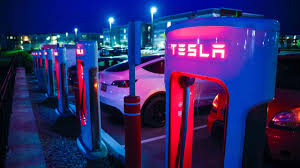Tesla’s recent decision to halt its aggressive expansion of electric vehicle (EV) chargers in the United States has stirred ripples across the industry, shifting the onus onto other companies to ramp up efforts to meet the growing demand for charging infrastructure. Elon Musk, CEO of Tesla, surprised stakeholders by reversing the company’s course on building charging stations, raising concerns about the pace at which public chargers will multiply to accommodate the surging sales of battery-powered vehicles.
The abrupt move to disband a 500-member team responsible for charger installations and to scale back investment in new stations has left the industry scratching its head, uncertain about the trajectory of charger deployment. This volte-face challenges other charging companies to fill the void and prompts questions regarding their capacity to address a shortage that may dissuade potential EV buyers.
With Tesla owning the largest charging network in the US, dubbed Supercharger, its actions wield significant influence over public perception of EVs. The availability and reliability of charging infrastructure play pivotal roles in the widespread adoption of electric vehicles.
Tesla’s retreat from its charger expansion plans, announced shortly after signaling rapid network growth, is poised to delay the construction of fast chargers, particularly along the coasts and in select areas like Texas. The ripple effect is evident in projects like Wildflower’s proposed charging center in Queens, which now faces setbacks following Tesla’s withdrawal.
Despite Tesla’s dominance in charging infrastructure—with 25,500 of the 42,000 fast chargers in the US—it remains uncertain whether other players can match its expertise and pace. The scarcity of experienced installers and the intricacies of charger deployment pose significant challenges to filling the void left by Tesla.
However, industry analysts suggest that Tesla’s pullback may not impede the overall growth of charging infrastructure, given the influx of government subsidies and private investments driving charger construction independent of Tesla’s initiatives. The sector’s professionalization and standardization of charging technology signal a maturing market that can adapt to Tesla’s strategic shifts.
Tesla’s pivot away from charging expansion may stem from financial considerations and strategic realignment towards emerging technologies like artificial intelligence and robotics. Opening Tesla stations to vehicles from other manufacturers may have also influenced this decision, potentially diluting Tesla’s market share in the EV landscape.
While Tesla’s move raises eyebrows, it underscores the dynamic nature of the EV market and the diverse stakeholders shaping its trajectory. Government agencies, charging companies, and electric utilities remain steadfast in their commitment to advancing charging infrastructure, undeterred by individual business decisions.
As the EV charging landscape evolves, collaboration among industry players and continued government support will be crucial in realizing the vision of a widespread, accessible charging network capable of driving the transition to electric mobility.
Contact Us:
For personalized consultation and inquiries about our charging solutions, please contact Lesley:
Email: sale03@cngreenscience.com
Phone: 0086 19158819659 (Wechat and Whatsapp)
Sichuan Green Science & Technology Ltd., Co.
Post time: May-07-2024





